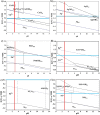Leaching of Metals from e-Waste: From Its Thermodynamic Analysis and Design to Its Implementation and Optimization
- PMID: 34056360
- PMCID: PMC8154117
- DOI: 10.1021/acsomega.1c00724
Leaching of Metals from e-Waste: From Its Thermodynamic Analysis and Design to Its Implementation and Optimization
Abstract
The aim of this study is to design and develop an efficient leaching process based on a fundamental and theoretical thermodynamic analysis and the optimization of the operation parameters via the response surface methodology (RSM). Using this methodology, the design of a leaching process for the recovery of copper, silver, and lead from highly metal-concentrated fractions of e-waste is presented. Thermodynamic predictions were performed through the construction and analysis of Pourbaix diagrams for the specific conditions of the leaching system. From this analysis, it was possible to determine the values of potential (E vs NHE) and pH at which the leaching reactions occur spontaneously. Additionally, RSM was useful to deduce a quadratic semiempirical model that predicts the copper leaching efficiencies as a function of two parameters involved in the leaching procedure, the stirring speed and the solid/liquid ratio, by which the response variable, the leaching efficiency, can be optimized.
© 2021 The Authors. Published by American Chemical Society.
Conflict of interest statement
The authors declare no competing financial interest.
Figures






References
-
- Cucchiella F.; D’Adamo I.; Lenny Koh S. C.; Rosa P. Recycling of WEEEs: An economic assessment of present and future e-waste streams. Renew. Sustain. Energy Rev. 2015, 51, 263–272. 10.1016/j.rser.2015.06.010. - DOI
-
- Forti V.; Baldé C. P.; Kuehr R.; Bel G.. The Global E-Waste Monitor 2020: Quantities, Streams, and the Circular Economy Potential; United Nations University, 2020.
-
- European Commission . Communication from the Commission—Towards a Circular Economy: A Zero Waste Programme for Europe; European Commission, 2014; Vol. 398, pp 1–14. https://ec.europa.eu/environment/circular-economy/pdf/circular-economy-c....
-
- Bhat V.; Rao P.; Patil Y. Development of an Integrated Model to Recover Precious Metals from Electronic Scrap - A Novel Strategy for E-Waste Management. Procedia Soc. Behav. Sci. 2012, 37, 397–406. 10.1016/j.sbspro.2012.03.305. - DOI
LinkOut - more resources
Full Text Sources
Other Literature Sources

